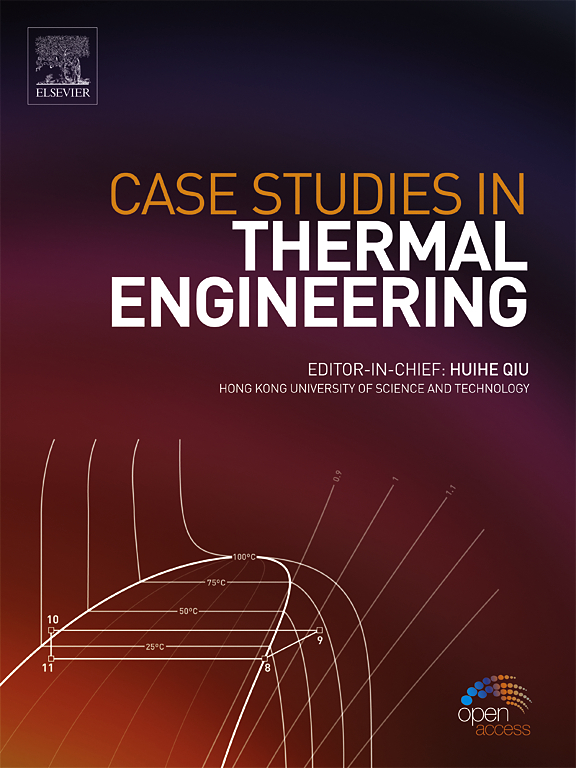印刷电路板组件中微型通道散热器实验设计的热特性分析方法
IF 6.4
2区 工程技术
Q1 THERMODYNAMICS
引用次数: 0
摘要
近年来,对新型、高效、省电冷却解决方案的需求日益增长。在许多情况下,标准冷却技术只能提供有限的机会来防止电路过热。这些问题涉及数据中心和电信机架中的高速印刷电路板组件(PCBA),由于空间不足,冷却介质的流动受到阻碍。在冷却大功率设备时,尺寸限制也是一个严重问题,因为这些设备需要占用很大的空间。由于基于散热器的冷却解决方案和复杂的集成电路封装只能处理一种可能的热流路径,因此我们有了加强通向印刷电路板(PCB)的次级热流路径的想法。在这一想法的引导下,我们实现了在电路板内创建嵌入式微型通道系统并循环冷却剂的想法。通过这种方法,我们可以大大降低电路板对环境的热阻。本文介绍了这种方法的演示和可行性研究。这项研究的主要目的之一是证明所提出的概念在 PCBA 中的适用性,PCBA 的主要问题是低成本可制造性和可用空间。另一个目标是对标准热表征方法进行调整,以处理 PCBA 演示器中的特定耗散元件。第一部分详细介绍了制造技术,并通过热瞬态测试和计算流体动力学(CFD)模拟对其效率进行了表征。在这些使用案例中,当微型通道的容积流量为 100 立方厘米时,累积热阻降低了约 60%。在第二部分中,通过在现有的高速 PCBA 中添加所建议的嵌入式微型通道散热器,实现了更复杂的技术演示并确定了其特性。专门针对这一使用案例实施了特定的热瞬态测试,并利用通用可编程逻辑构建必要的测量方法,在可编程逻辑器件上进行测试。今后,这一功能可用于无法直接确定结温的不同逻辑电路设计中。本文章由计算机程序翻译,如有差异,请以英文原文为准。
Thermal characterization methodologies for experimental minichannel heat sink designs in printed circuit board assemblies
There has been a growing demand for novel, highly efficient, power-saving cooling solutions in recent years. In many cases, standard cooling techniques offer only limited opportunities to prevent the overheating of circuits. Such issues concern high-speed Printed Circuit Board Assemblies (PCBA) in data centers and telecommunication racks, where the flow of the cooling medium is obstructed due to the lack of space. Size limitations can also be a serious problem when cooling high-power devices because the devices consume a large space. Since the heat sink-based cooling solutions and the sophisticated IC packages only deal with one possible heat flow path, we were given the idea of enhancing the secondary heat flow path towards the Printed Circuit Board (PCB). Led by this intention, the idea of creating an embedded minichannel system inside the circuit board and circulating the cooling agent was realized. Through this method, we could decrease the board-to-ambient thermal resistance significantly. This paper presents the demonstration and feasibility study of this method. One of the main aims of this study is to demonstrate the applicability of the proposed concept in PCBAs, where the primary concerns are the low-cost manufacturability and available space. The other goal is to create an adaptation of the standard thermal characterization methodologies to deal with the specific dissipating components in the PCBA demonstrators. In the first part, the manufacturing technology is elaborated on, and its efficiency is characterized by thermal transient testing and Computational Fluid Dynamics (CFD) simulations. For these use cases, it was noted that the cumulative thermal resistance decreased by approximately 60 % when a volumetric flow rate of 100 ccm was applied in the minichannels. In the second part, a more sophisticated technology demonstration is realized and characterized by adding the proposed embedded minichannel heat sink to an existing high-speed PCBA. A specific thermal transient testing was implemented specifically for this use case, and it was carried out on programmable logic devices by utilizing general-purpose programmable logic to construct the necessary measurement methods. In the future, this feature can be used in different logic circuit designs where it is not possible to determine the junction temperature directly.
求助全文
通过发布文献求助,成功后即可免费获取论文全文。
去求助
来源期刊

Case Studies in Thermal Engineering
Chemical Engineering-Fluid Flow and Transfer Processes
CiteScore
8.60
自引率
11.80%
发文量
812
审稿时长
76 days
期刊介绍:
Case Studies in Thermal Engineering provides a forum for the rapid publication of short, structured Case Studies in Thermal Engineering and related Short Communications. It provides an essential compendium of case studies for researchers and practitioners in the field of thermal engineering and others who are interested in aspects of thermal engineering cases that could affect other engineering processes. The journal not only publishes new and novel case studies, but also provides a forum for the publication of high quality descriptions of classic thermal engineering problems. The scope of the journal includes case studies of thermal engineering problems in components, devices and systems using existing experimental and numerical techniques in the areas of mechanical, aerospace, chemical, medical, thermal management for electronics, heat exchangers, regeneration, solar thermal energy, thermal storage, building energy conservation, and power generation. Case studies of thermal problems in other areas will also be considered.
 求助内容:
求助内容: 应助结果提醒方式:
应助结果提醒方式:


